Star Calendar: A House of Order
by John P. Pratt
25 Jun 2017, 1 Rabbit (SR), 1 Fulness (V), 1 Summer (E), Ram (US)
©2017 by John P. Pratt. All rights Reserved.
| 1. In a Constellation |
| 2. Righteous Figures |
| 3. Bright and Meaningful |
| 4. Stick Figures |
| 5. Order of Placement |
| 6. Draco: Lord or Impostor? |
| 7. Equal Angels |
| 7.1 Identical Twins |
| 7.2 All Seven Angels |
| 8. Star Calendar Mature |
| 9. Conclusion |
| Notes |
All 364 stars of the Star Calendar have been identified and ordered to correspond to each day of the year.
Three decades ago when in my work it was noticed in the Book of Enoch that there are 364 faithful servants of the Lord who are each identified with a star on a 364-day Star Calendar, the task of identifying those stars seemed impossible. Enoch explains that the stars are sectioned into four quadrants of the zodiac circle, with each division marked by a bright star. Those four cornerstone stars and the four great servants they represent were identified in 2001,[1] but almost no progress was made in identifying more stars until last year when some of the brightest stars were identified as corresponding to holy days on the Star Calendar.[2] Even so, the task of filling in more than 300 remaining stars seemed beyond reach.
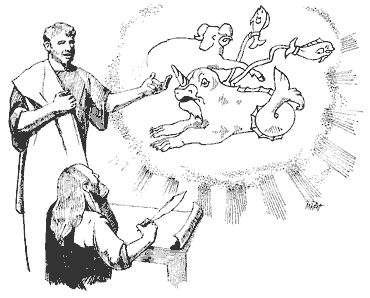 |
Think about it! The sky is filled with 4,000 visible stars[3] apparently randomly sprinkled around the night sky. From all of those, how is one to pick the right 364 (to which Enoch referred) and then organize them so that each corresponds to a day on a calendar which the Lord uses?
Let us now see how the problem becomes resolvable because the Lord has revealed patterns that ultimately allow every one of those stars to be identified! After each of those pattern constraints is discussed, a proposed list of all 364 stars is presented. Those stars are then put in order according to the pattern shown, resulting in the Star Calendar now being mature enough that it has been added to my Calendar Spreadsheet. Let us now see the patterns which allow the correct 364 stars to be identified from the candidate list of 4,000. In creation, the Lord brings order out of chaos. His house is a house of order (D&C 88:119). We shall see how apparently random stars can be placed in a very precise order to count days on a calendar.
This article is somewhat technical and describes the process in detail of exactly how the identity of each star in the Star Calendar was discovered. It discusses the clues the Lord gives us to discover truth (D&C 52:14). How this calendar has been used by the Lord throughout history is not discussed, but the results of what religious events occurred on which star dates has been updated on my Religious Chronology. Let us now look at several patterns the Lord has provided which supply constraints as to just which stars may be included in the Star Calendar.
1. In a Constellation
What patterns has the Lord revealed that might allow the identification of exactly which stars are included in the Star Calendar? The first set of patterns to consider would be the constellations figures themselves, which according to the Book of Enoch were revealed to Enoch by an angel.[4] Those certainly qualify as patterns.
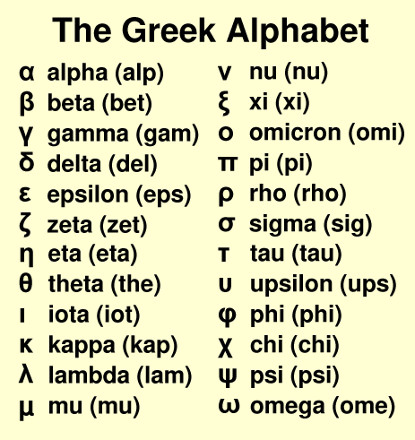 |
One unexpected benefit of this process of star hunting was an improved list of the constellations themselves.[5] Once the correct set of original 48 constellations had been identified, the first criterion is that all 364 stars must be chosen from stars included in those (restored[6]) constellations. A Restored Constellation Star Catalog has recently been published which lists nearly 1,000 stars.[7] It lists all of the stars which form part of the figure of each constellation.
The brightest stars are identified by a Greek letter followed by a three letter abbreviation of the Latin name of the constellations, using internationally agreed star designations. For example, the brightest star in the sky is Sirius, designated α CMa (alpha Canis Majoris, the Big Dog). Because this article refers to many stars, Table 1 lists the Greek alphabet. The constellation of the Maiden (Virgo) used in the Star Calendar contains 21 stars, of which 20 are identified with Greek letters from alpha to omega (α to ω). When astronomers ran out of Greek letters, numbers were assigned to the other stars. For example, the remaining star included in the Maiden is identified as 32 Vir.
Thus, in this manner, the first constraint on a potential Star Calendar candidate is that it must be chosen from that catalog. Thus, the 364 are to be chosen from those 1,000 stars rather than the entire set of 4,000 visible stars. The constellation figures themselves are the “patterns” which become the first constraint as to what stars can be used in the Star Calendar.
2. Righteous Figures
 |
Another constraint implied by the Book of Enoch is that the stars to represent righteous servants of God would be chosen from the “righteous” constellations. There are many heroes and villains represented in the heavens. Most are clearly indicated by their placement in the heavens. Those in the far north (near the north ecliptic pole) are the most righteous, such as the Swan (Cygus) and the Flying Horse (Pegasus). The evil ones in the far south, such the Sea Monster (Cetus), the Water Serpent (Hydra), and the adulterous Hare (Lepus), do not seem like they would contain any star to honor a holy man. In constellations which contain both, such as the Hero (Perseus), who holds the decapitated snake-haired head of the evil Medusa he has slain, none of the stars in her head would be included.
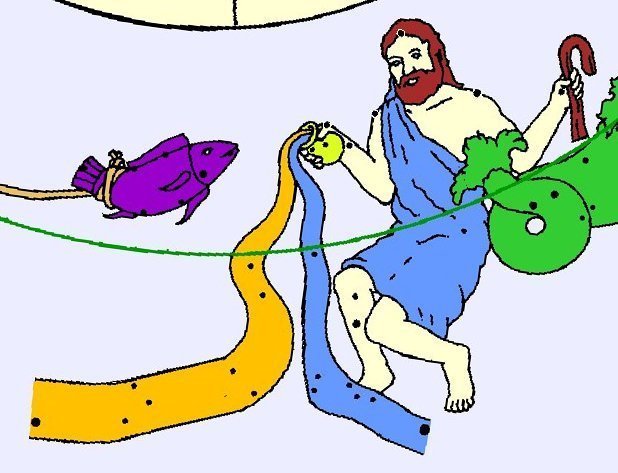 |
Another example of a constellation with both good and bad star symbolism is the Waterman (Aquarius). It was recently discovered that the two streams which are being poured out of his jar represent the blessings and cursings which result from keeping or breaking a covenant (the jar) with the Lord (the Waterman). The right stream ends on the head of the Southern Fish (the Church of Christ) and the left stream ends on the tail of the Sea Monster.[8] In this study, only stars in the stream of blessings were considered as candidates.
One question which arose concerned the constellations of the Ship (Argo) and the Centaur (Centaurus) which are both located far south. There is nothing evil noted about them in the myths, as there is about the monsters. Should they be included or not?
The question was easily answered. Because of how the stars need to fall into the slots for each day, it was found that there are far too many stars in the area of Centaurus for any of those to be included, whereas the stars of Argo are absolutely needed. The latter makes sense because the passengers (called the “argonauts”) were seeking everlasting life and included some heroes such as Hercules and both of the Twins (Gemini). Those leaders were good, but the passengers seeking a good resurrection apparently had to be redeemed from hell to get it!
3. Bright and Meaningful
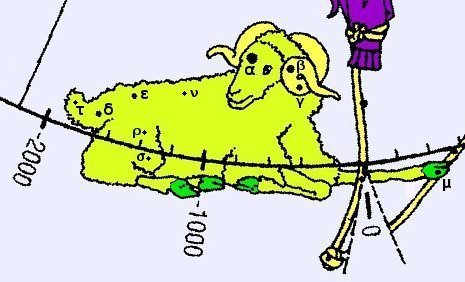 |
Another obvious criterion for inclusion is the brightness of a star. In common parlance, referring to someone as a “bright star” or “shining star” clearly implies the person is a stellar example. This constraint is supported by the fact that nearly every bright star in the heavens represents Christ in some role. The “evil” constellations as a rule have no bright stars at all. Most people cannot find the constellation of the Sea Monster (Cetus) or the Water Serpent (Hydra) even though they are very large.
Brightness alone cannot be the only criterion for star selection. Some stars are located in very meaningful locations in the figure. Thus, a dim star in the ear of the Bull (Taurus) might not seem worthy of inclusion until it is realized that the Bull can represent a seer and not only do his eyes represent those of one who sees spiritually, but the ear may well represent a “hearing ear”. It could turn out that someone with the gift of hearing (Mat. 13:9) may have been born on the day of that star which perhaps could be named “Hearing Ear”.
Thus, in the quest to find these stars, a balance is sought between brightness in unimportant places versus dimness in a very meaningful place. For example, the Savior was born on the day of the dimmest star included in the Star Calendar from the constellation of the Ram (Aries), being ν Ari. Even though dim, it is located in the Ram’s golden fleece, which represents resurrection.[9] On the Sacred Round He was born on 1 Reed which represents resurrection. So the star day of His birth is important and the dimness of the star may correspond to the fact that he was born in a stable. His resurrection occurred on the day of the brightest star “Ram” (Hamal) in the Ram’s head.
Another part of “meaningful” could well be the traditional spiritual meaning of the number of stars used from each constellation. Would the numbers be simply random numbers of the stars needed to form the figures or would star counts also be important? The pattern the Lord has given us in His parables (and even miracles) is that whenever a number is mentioned, it is significant (Mark 8:18-21). In this work, it turned out that the number of stars in each constellation is important. There are many constellations with seven stars, a number of completion, and with twelve stars, another sacred number often associated with judgment (as on a jury). The Scorpion (Scorpius), Archer (Sagittarius) and King (Cepheus) are all associated with judging and all ended up with twelve stars. The constellations dealing with resurrection have eight stars, symbolizing resurrection.[10]
4. Stick Figures
During this work, a question arose concerning “stick figure” representations of constellations: are they important? Some sophisticated astronomers believe they are childish and hence they publish star atlases filled with little star dots that appear to be totally random. To me these atlases are like what a map of the earth would be without any borders of countries or states. Those borders make it really easy to recognize cities and the stick figures make it really easy to identify stars in an otherwise random sky. The most useful star atlases now include the stick figures which really speeds up finding stars.[11]
So does God like stick figures? That is, besides choosing bright stars in meaningful locations, is He also going to pick stars that make an easy stick figure for the backyard stargazer to easily identify?
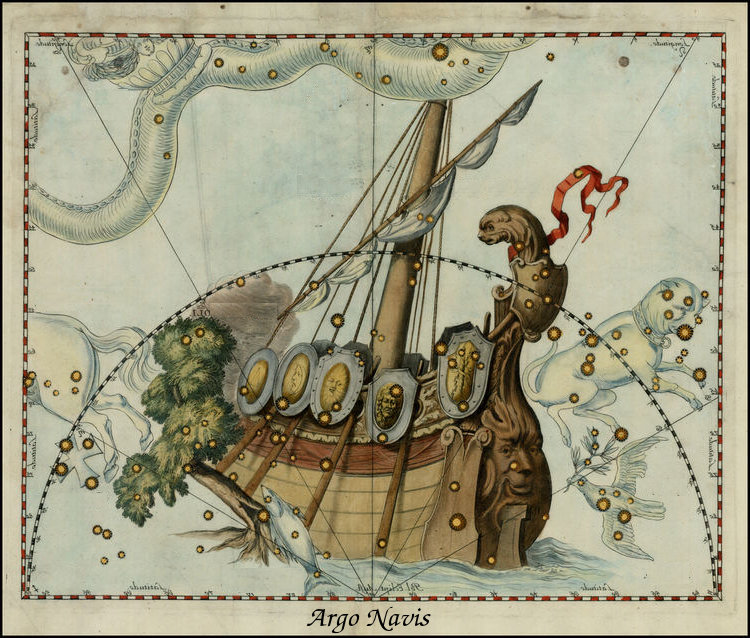 |
Another way to ask the question scientifically is to wonder if my choice of stars to consider is influenced by the stick figures known to me. Most of the stars finally chosen did indeed form nice stick figures, but was my bias included in that choice which might lead to incorrect stars? Even some traditional stick figures look totally random. Some look exactly like what they are supposed to, like the Scorpion (Scorpius), but those for the Balance (Libra) usually don’t look anything like a balance scale. So are they important or not?
A perfect test case came up in the constellation of the Ship (Argo Navis, or simply Argo). This is a large constellation so far south that most of it is no longer visible, due to the precession of the equinoxes. In the 1800’s astronomers broke it into four separate constellations because it was so big and contained so many stars. Thus if you look now for a good picture of Argo, you need to look at maps made before that time.
In particular, when this star quest was begun, there was no stick figure representation of Argo at all known to me. All that can be found is stick figures of the Sail (Vela), Keel (Carina), Deck (Puppis) and the Mast (Pyxis). The best illustration of Argo known to me is by Johannes Hevelius (1611-1687) shown in Figure 1, which was made before stick figures became popular. How would you connect the dots to draw a ship?
Click once on the illustration to see the brighter stars better because the 22 brightest are labeled. How many of those 22 should be used and which ones? Could they be connected to make anything which looks like a boat?
The number of stars in the Star Calendar is determined by the availability of slots. When the work was completed, it turned out there were exactly eight stars for Argo, the very number representing resurrection! But what about the stick figure? Would the needed stars form a stick figure? It turns out the eight stars form a loop which is not a good likeness of a ship but it is easily recognized, which is the main purpose of a stick figure. Clicking on Figure 1 again shows the resultant stick figure.[12]
5. Order of Placement
The Star Calendar assigns one star to each day of the year. The stars are assigned according to their location in the heavens. There are about 1,000 visible stars that are associated with the constellations figures and only 364 days in the star year (plus 7 more in leap years), so only about a third of the constellation stars can be used in the Star Calendar. Some areas of the sky are filled with many stars, so the choice of exactly which stars may depend on all of the selection criteria. Some constellations with many bright stars are in areas with many other bright stars, so only a few bright stars might be included from that area. An example is the Hunter (Orion), having many bright stars, of which only seven were allowed to be used. And yes, they were the very seven with form the familiar hourglass-shaped stick figure.
The order of placement of a star on a day of the year is determined mostly by the sidereal longitude, which was explained in an earlier article.[13] The basic idea is similar to the practice in astrology of assigning a person to a zodiac constellation (“What’s your sign?”) according to where in the zodiac the sun is thought to be on the day of birth. The Star Calendar does the same thing precisely: each day is assigned to a star which is nearly directly above or below the sun on its apparent annual zodiac path (the ecliptic).
This means that any given star can only be exactly matched to one certain day of the year. There may be several stars which might mark that same day because there are 1,000 for 364 days, but only one star can be chosen for each day. There are some days where there are only one or two stars available so there isn’t much choice in that case.
A common exception to this rule is that (1) holy days can be marked by the brighter stars even if they don’t fall exactly into the right slot and (2) stars can be adjusted by up to a week from the correct day as long as the stars are kept in the same order of their ideal slots.
6. Draco: Lord or Impostor?
Now let us return to the criterion in Section 2 of including only constellations of righteous figures. There is one constellation which seems to be totally misplaced. The Dragon (Draco) encircles the north pole of the zodiac circle, which represents the highest point in heaven. What is the evil Dragon doing being placed there when all of the other evil creatures are down in the area of hell and perdition?
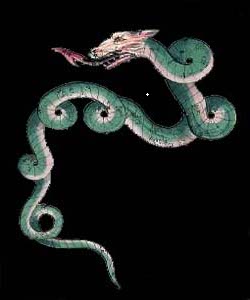 |
Are we sure the Dragon is evil? The Chinese revere the Dragon as being good. There are several reasons that the Dragon appears to be evil. First, Hercules has his left foot crushing the head of the Dragon, even as the Healer (Ophiuchus) is crushing the head of the Scorpion with his left foot. Second, in the Book of Revelation, John saw the sign in the sky (constellation) of the Dragon attempting to devour the child of the sign of the Maiden (Virgo). And finally, Isaiah tells us that Lucifer wanted to exalt his throne above all of the stars in heaven, most likely to take up residence at the very “top” of the sky (Isa. 14:13), which would be the north pole of the zodiac circle. None of this sounds very promising for the Dragon to be good!
But wait, there are questions to be answered. First, was Lucifer successful in taking over heaven? Did the angel reveal constellations to Enoch which show the devil hijacking heaven? It is one thing to want to exalt oneself, but quite another to succeed. In fact, that very scripture about Lucifer states that he will fail and be cast down to hell (Isa. 14:15). So what is the constellation of the Dragon doing encircling the top of the sky? (See Figure 2.)
Here it seems essential to note that Satan fulfills two important roles. On the one hand, he is the epitome of evil and entices people to break the commandments of God. He enslaves victims to habit forming sins. The constellations in the far south represent many of those aspects of evil, such as the promiscuous Hare.
But Satan has another tactic to enslave the rest of the world who wish to follow God and not sin. For them he claims to be God (or His Son) and to have a better plan than that of Jesus. His plan demands that everyone obey him, enticing them to trade their freedom for the security he promises to provide. Then he leads them, who may believe they are following God or his prophet, very carefully down to hell (2 Nep. 26:22, D&C 76:100).
What if the Dragon is indeed a symbol of God? What better way is there for Satan to impersonate Him as an impostor than to use the same symbol of a dragon? Remember when Moses told the children of Israel to look at the fiery flying serpent on the pole in order to be healed (Num. 21:9)? That serpent represented their God Jehovah who became Jesus Christ in mortality (1 Nep. 17:41).[14] Moses wasn’t using a symbol of Satan! It is the other way around: Satan uses the symbol of God to fool everyone!
With all of that in mind, it was determined that the constellation of Draco actually represents God who indeed does sit on throne of heaven, but sometimes it is also the impostor who only wishes for that honor. This has not been stated in any of my previous articles, nor ever so clearly understood in my work before. In a similar manner, the Scorpion can sometimes represent Satan (as when his head is being crushed) but it can also represent the judgment of God who holds the balance of justice (Libra) to weigh the deeds of men. Many symbols have double meanings.
How many stars should the Dragon have? The actual constellation is long and winding with many stars. It ended up having twelve stars, and those twelve also happen to be the twelve best to draw the stick figure!
7. Equal Angels
This brings us to by far the most stringent criterion to determine exactly which stars are in the Star Calendar. It was the discovery of this principle which made this article possible. Before it was discovered, there were stars for every slot, but very little confidence that they were correct. That preliminary result was not worthy of publishing because it was almost certain to change with new discoveries. The problem was that there were several candidates which might fill several of the slots and there was no way to decide between them.
After the discovery of this principle, it became so hard to fit stars into acceptable slots that it was nearly impossible to find any solution at all! But a solution was finally found! What is this amazing new criterion? It comes from the parable the Lord that a just man having twelve sons will not dress one in rich robes and another in rags (D&C 38:26). What if the pattern of that parable is applied to the seven angels who each have seven constellations assigned to them.
7.1 Identical Twins
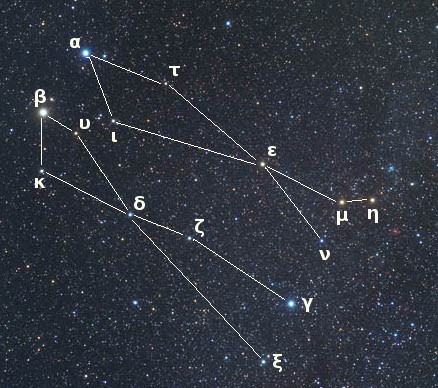 |
The first application of this constraint was to the two angels Sariel and Phanuel (Abel and Joseph Smith) who are the Twins (Gemini), the Warrior and the Champion (Castor and Pollux), respectively. For the purposes of counting the 48 constellations as 49, the Twins are separated into two constellations in different columns of the sky called the Warrior and the Champion, for a total of 49.[15]
There are enough stars in the Twins for each to have about nine, but there are not enough slots to allow that many. So how can the choice be made between rival candidates that are all about equal brightness and in important positions? In pondering this, the principle of equality arose and it was clear that each should have the same number of stars!
Then it was noticed that the stick figures of the constellations can made to look almost identical if certain stars are chosen, using either six or seven stars. The number of slots required seven, but the form of the stick figures made the final determination of which seven for each. As shown in Figure 3, each twin has a head, 2 shoulders, one waist, two feet, and another star in the left leg or foot.[16] Thus, patterns and principles were used to determine every star in the Twins.
7.2 All Seven Angels
The second application of the principle affected the choice of stars for every single constellation! If the Lord treats two of His seven angels as equals, then according to the parable, He will treat all seven of them equally. In particular, each of the seven angels will be assigned the same number of stars. In a year of 364-days each angel must have a total of exactly 52 stars in his constellations included in that year!
In a leap year with an extra week (371 days), the entire extra constellation of the Cup (Crater) in Adam’s column is inserted into the year. Any event on a star day in the Cup is known to be at the end of a leap year. The Cup is indeed located under the last zodiac constellation of Leo, so it works as if it were planned!
Until one tries to meet this rigorous criterion, he may have no idea how difficult it is to fulfill. For me it was a full week of long days after a proposed solution was already known. It is not easy to change the number of stars in a constellation given that the number in each should be symbolic and the particular stars must form a nice stick figure and either be bright or be located at a meaningful location in the figure. It is tough to meet all of the criteria for every star! But one solution has been found which will now be presented.
8. Star Calendar Mature
Figure 4 shows the 7×7 grid of constellations arranged so that they show which constellations are associated with which angel, whose names in mortality appear at the top. The Greek letter designations for each of the stars in that constellation which are included in the Star Calendar are indicated in the box with the constellation name shown. Those with 5 or fewer stars show the letters in a stick figure of the constellation. Note that the Balance looks just like a balance with one scale lower, even though it only has five stars!
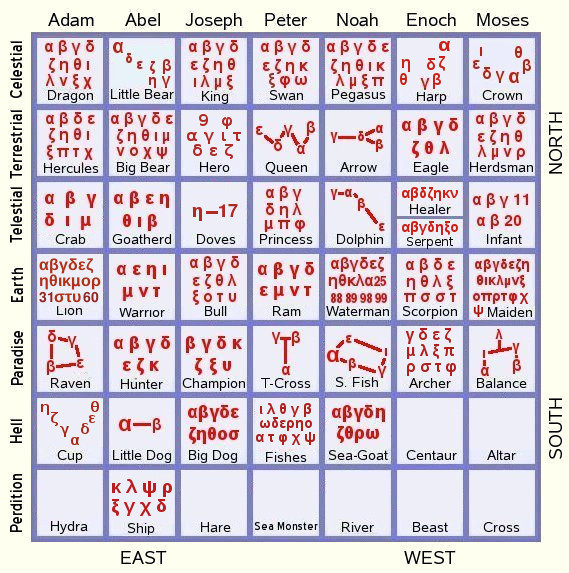 |
Counting all of the stars in each column shows that there are exactly 52 stars in each column. That is no coincidence, it is the result of long and careful organization in bringing order out of chaos! The first solution found in my work before this “Equal Angels” principle was discovered had 57 stars in Enoch’s column and only 45 in Joseph’s. At least 20 stars were changed to arrive at this new solution, with each change making a better solution in terms of a stick figure or more symbolic number.
Clicking on Figure 4 shows the total number of stars for each constellation, with the total for each column indeed being 52 as required. Clicking again on the figure shows the icons for each constellation.
It should also be noted that several stars were considered by the ancients to belong to two constellations. Today, astronomers recognize the star α And as both the head of the Princess and the navel of Pegasus.[17] It is not so well known that the bright star Fomalhaut (α PsA), one of the four cornerstone stars found in the head of the Southern Fish, was also considered to be at the end of the righteous stream of Aquarius. Thus, the letter α is shown twice in the box for the Waterman, once for each constellation.
If a star is one that is in two different constellations and if both are included in the Star Calendar, then they are assigned to consecutive days. For example, on the day of the appearance of the Savior, Moses, Elias and Elijah in the Kirtland Temple on Sunday 3 Apr 1836, the vision occurred after noon (DHC 2:435). Because the day on the Star calendar begins at noon, the morning of that day was on the star day of δ Peg (called “Sire” referring to fathers and children) and the afternoon was on the day of α And, being the day representing the head of the princess bride (Andromeda), i.e., the head of the Lord’s church. Both are the same star, which is part of both constellations. To avoid confusion, a star in two constellations is now given only one Greek designation, so δ Peg is nearly always called α And.
The biggest change caused by this principle was to the Dragon. In my first attempt to determine the 364 stars, he had been allowed only 7 stars in the “Pattern of Seven”, which seemed symbolic both in number and shape.[18] But it really was a forced fit because that pattern is for figures shaped like the Big Dipper with four stars in a big square with a tail of three about the same length as the square. Draco has a tiny head of four stars with a huge tail of 26 stars, of which only three were supposed to be representative! In order to make the totals add up correctly, stars in Draco needed to be added because they were the only ones available. That is because he encircles the throne and has stars located in the column of most of the angels. That is the only constellation with that feature. Nearly all of the other constellations fit squarely into either one or two columns. The chart is an actual map of the heavens. In the process, one by one more stars were required to be added to the Dragon, totaling twelve of the brighter stars which extended all the way to include the tip of his tail (λ Dra).
Often when a star was added to Draco it turned out to be on an important religious event! For example, Abraham was born on the Star Calendar day ν Dra, now named “Word” (Logos) in my work because it is in the mouth of the Dragon.[19] Moreover, Abraham was also born on the day ζ Dra (named “Exalted”) on the Uniform Star Calendar (US)[20]! That makes two witnesses that this is not random! That star is so named because it is the star in the Star Calendar nearest to the throne of God (ecliptic pole). Amazingly, Jacob, Gad, Aaron, and John the Baptist were all also born on “Exalted” (US)! Indeed, it could be even said of John the Baptist that no prophet was born of women on a more exalted day (Luke 7:28). Enoch the Seer was born on the day of the (all-seeing) eye of the Dragon (β Dra)! And as for the women, Rebekah and Miriam were born on δ Dra and Rachel died on that day. These stars are not of Satan, but of God!
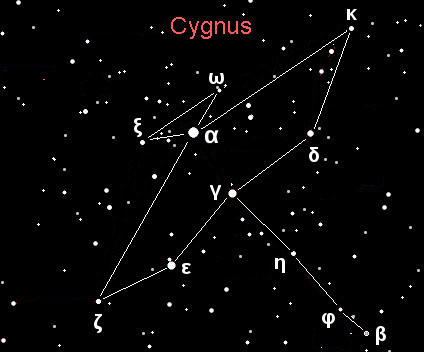 |
Figure 5 illustrates the constellation with the most improved stick figure resulting from the Equal Angels principle: the Swan (Cygnus), which is often called the Northern Cross because of its crucifix shape (click it to see). When this star search began, because star slots only allow a third of the stars in a constellation to be utilized, the Swan was allotted only the six in the crucifix. One by one stars were required to be added until it had eleven! The stars were added according to where there were empty slots, and Figure 5 shows the excellent stick figure which resulted. Its perfect symmetry and accurate shape are compelling evidence that stick figures for the common man were in mind from the beginning of the design of the constellations! Moreover, the final star to be added to the entire set of 364 was φ Cyg which had been entirely overlooked. It had to be added because it fit into the last slot. It turns out it is the head of the Swan (the brighter β is the beak). That means it is the head of the celestial Church (D&C 107:19)! That seems fitting to have that humble star finally take its deserved place in such a key location!
All 371 stars (364 + 7 more in leap years) proposed to be used in the Star Calendar along with their names, assigned day of the year, and other information are available in a downloadable spreadsheet file available on this website at “Star Calendar Star Catalog“.
9. Conclusion
The daunting task of identifying all 364 stars in the Star Calendar has been attempted, resulting in a proposed ordered list of stars to represent every day of the year. The criteria for selection were (1) being in an original restored constellation, (2) representing “good” rather than “evil”, (3) being bright, (4) being located in a meaningful position in the figure, (5) having a symbolic number of stars in each constellation, (6) forming part of an appropriate stick figure, (7) being placed in or near the day determined by its longitude, and (8) contributing to a total of exactly 52 stars in all of the constellations assigned to each of the seven chief angels. There are very few sets of 364 stars which meet all of those criteria. The best solution known to date has been presented herein and used to implement the Star Calendar and Uniform Star Calendar in the Calendar Spreadsheet program on this website. The order that this calendar imposes on the otherwise chaotic-looking star placement in the heavens is a witness that the position of the sun and earth in the galaxy was done by the hand of a brilliant Creator.
Notes
- Pratt, John P., “The Lion and Unicorn Testify of Christ Part II: The Four Royal Stars” (5 Dec 2001) includes a detailed discussion of the Book of Enoch references and identification of the four angels and four stars: Michael (Adam) – Regulus, Gabriel (Noah) – Fomalhaut, Phanuel (Joseph Smith) – Aldebaran, and Raphael (Enoch) – Antares.
- Pratt, John P., “Star Calendar Testifies of Christ and His Servants” (9 Jul 2016).
- Pratt, John P., “The Mag 5 Star Catalog” (14 Dec 2015) contains nearly 4,000 stars including all visible to most people (to 5.5 magnitude).
- Pratt, John P., “Enoch’s Constellations Testify of Christ” Meridian Magazine (23 Aug 2006).
- Pratt, John P., “T-Cross Constellation: It Is Finished” (30 May 2017) replaces the constellation of The Wreath with the T-Cross, proposed as the correct way to see Triangulum. That completed the list of 48 constellations.
- In addition to the article referenced in footnote 5, see also my “Lost Constellation Testifies of Christ” Meridian Magazine (14 Jul 2004), “Seeking the Original Constellations” (24 Dec 2015), “The Forgotten Left Stream of Aquarius” (9 Jan 2016), and “The Scorpion Metes Out Justice With His Balance” (4 Feb 2016) and “Capricornus: A Thorn in the Side” (25 Mar 2016).
- Pratt, John P., “Restored Constellation Star Catalog” (30 May 2017).
- Pratt, John P., “The Forgotten Left Stream of Aquarius” (9 Jan 2016).
- In the myth of Jason and the Argonauts, their long quest was all in search of the Golden Fleece, which brought eternal life. See my “Enoch’s Constellations Testify of Christ” Meridian Magazine (23 Aug 2006) Section 2.8 “The Ram”, which associates the Ram with resurrection, and “Star Calendar Testifies of Christ and His Servants” (9 Jul 2016) Section 3.1 “Birth Date”, which identifies the star ν Ari as representing the Golden Fleece.
- The Book of Barnabas explains the Christ resurrected on the eighth day of the week, which of course is Sunday, the same day as the first day. See “Sacred Calendars Support Christian Worship on Sunday” (18 Sep 2016) Section 2.2 “Celebrates the Resurrection”.
- For example Tirion, Wil, The Cambridge Star Atlas (Cambridge, UK: Cambridge U. Press, 2011).
- When Agro was broken up into four constellations, the original Greek letter designations were kept for the Sail (Vela), Keel (Carina) and Deck (Puppis). Thus, each letter shown in the illustration is sufficient to identify the star. In the case of the three stars in a straight line in the Mast, they were transformed into a Mariner’s Compass (Pyxis) and new Greek letters were assigned. Thus in the illustration, the Star Calendar star α refers to that in the mast rather than to the one at the bottom of the ship.
- Pratt, John P., “Star Calendar Testifies of Christ and His Servants” (9 Jul 2016) Section 1.1 “Aligned with Week” has a good illustration in Figure 3.
- Millett, Ronald P. and Pratt, John P., “What Fiery Flying Serpent Symbolized Christ?” Meridian Magazine (9 Jun 2000) attempts to identify the species of the fiery flying serpents. Another indication that the red Dragon is indeed God is found in the Book of Revelation itself (Rev. 4:2-3) which says that the color of Him who sat on the throne of heaven was colored reddish-orange, the color of a jasper or sardius stone. It doesn’t say he was in human form; Christ was represented by a lamb (Rev. 5:13).
- The constellation of the Bull (Taurus) is also split into two, the Doves (Pleiades) and the Bull. Moreover the Healer (Ophiuchus) and his entwined Serpent (Serpens) are counted as one, still leaving the total 49.
- Note that the star υ Gem is in the Twin on the left (Pollux), whereas Ptolemy placed that star in the back of Castor. He admitted that he changed the location of some stars to make the figures look as he saw them. It is here proposed that virtually all stick figure versions make it clear that that star is part of Pollux.
- In this table, the alternate designation δ Peg is used for the star nearly always called α And when referring to it being part of Pegasus.
- Pratt, John P., “Priesthood Pattern of Seven” Meridian Magazine (31 March 2011).
- A downloadable version of Ptolemy’s star catalog, complete with his descriptions of the location of every star in each constellation figure, has been published in my work as a spreadsheet at “The Ptolemy Star Catalog” (14 Dec 2015).
- The Uniform Star Calendar is the other version which never adds a leap week but always has exactly 364 days.

